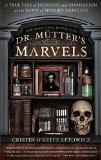Summary | Excerpt | Reviews | Beyond the Book | Readalikes | Genres & Themes | Author Bio
A True Tale of Intrigue and Innovation at the Dawn of Modern Medicine

Critics' Opinion:
Readers' Opinion:
First Published:
Sep 2014, 384 pages
Paperback:
Sep 2015, 384 pages
 Book Reviewed by:
Book Reviewed by:
Poornima Apte
Buy This Book
Thomas would never see his father again.
Four months into this journey, on a winter's passage of the Alps, John Mutter died.
It would, of course, take weeks for the news to make its way to America. In Thomas's mind, his father was still very much alive when the first alarming symptoms of his grandmother's illness began to show.
Frances had been a martyr for many years to gout, a cruel and painful disease that caused various joints on her body—her fingers, her toes, her elbows, her knees—to swell painfully. The affected parts would turn bright red and become hot to the touch. She could scarcely stand for Thomas to be in the room with her when it got really bad, as air whipped up by his energetic body felt like a thousand needles piercing her skin.
But his grandmother's health now seemed worse. As her body grew weaker, the pain grew more oppressive. A doctor's widow, Frances tried to self-treat her ailment with food, drink, and rest, but nothing was working. Doctors were eventually called, and young Thomas could do nothing but watch as his grandmother endured the same treatments he'd watched both his parents suffer through: Her arms were sliced with small razors to "bleed out" her bad blood; heated glass cups were applied to skin to force out more "bad humors"; and unknown purgatives were given to her in liquid and solid form, causing her to vomit and her bowels to loosen and empty violently.
It was a truth that everyone in that era knew: Oftentimes the treatment was even worse than suffering with the disease itself.
Frances Gillies lived just long enough to hear the news of the passing of her son-in-law, and to share it with her devastated grandson. Then she passed away too.
Thomas Dent Mutter was just seven years old, and every person who had ever loved him was dead.
• • •
Thomas Dent Mütter's story is not so surprising if you consider that a man did not need a medical degree to practice medicine in early nineteenth-century Philadelphia. In fact, he didn't even need a license—a practice that Philadelphia would not embrace until the final decade of the nineteenth century.
Although the tide was changing, the clear truth was that anyone who wanted to put out a shingle and call himself a doctor could do just that.
Even those doctors who followed due process—apprenticed under local doctors, went to medical colleges and studied hard, practiced often and kept as up-to-date as possible with the latest innovations—still struggled with the medical limitations of the day.
Medicine was performed literally in the dark. Electricity was newfangled and unpopular. Almost every act a doctor performed—invasive examinations, elaborate surgeries, complicated births—had to be done by sun or lamplight.
Basics of modern medicine, such as the infectiousness of diseases, were still under heavy dispute. Causes of even common diseases were confusing to doctors. Benjamin Rush thought yellow fever came from bad coffee. Tetanus was widely thought to be a reflex irritation. Appendicitis was called peritonitis, and its victims were simply left to die.
The role that doctors—and their unwashed hands and tools—played in the spread of disease was not understood. "The grim spectre of sepsis" was ever present. It was absolutely expected that wounds would eventually fester with pus, so much so that classifications of pus were developed: A "yellow ooze" was seen as a good "laudable pus" while an "ichorous pus" (a thin pus teeming with shredded tissue) was viewed as "the stinking herald of cadaverous putrefaction."
Medicine was not standardized, so accidental poisoning was common. Even "professionally" made drugs were often bulky and nauseating. Bleeding the ill was still a widespread practice, and frighteningly large doses of purgatives were given by even the most conservative men. To treat a fever with a cold bath would have been "regarded as murder."
Excerpted from Dr. Mütter's Marvels by Cristin O'Keefe Aptowicz. Copyright © 2014 by Cristin O'Keefe Aptowicz. Excerpted by permission of Gotham Books. All rights reserved. No part of this excerpt may be reproduced or reprinted without permission in writing from the publisher.





The House on Biscayne Bay
by Chanel Cleeton
As death stalks a gothic mansion in Miami, the lives of two women intertwine as the past and present collide.

The Flower Sisters
by Michelle Collins Anderson
From the new Fannie Flagg of the Ozarks, a richly-woven story of family, forgiveness, and reinvention.

The Funeral Cryer by Wenyan Lu
Debut novelist Wenyan Lu brings us this witty yet profound story about one woman's midlife reawakening in contemporary rural China.
Your guide toexceptional books
BookBrowse seeks out and recommends the best in contemporary fiction and nonfiction—books that not only engage and entertain but also deepen our understanding of ourselves and the world around us.